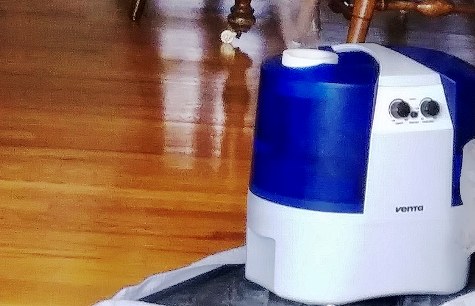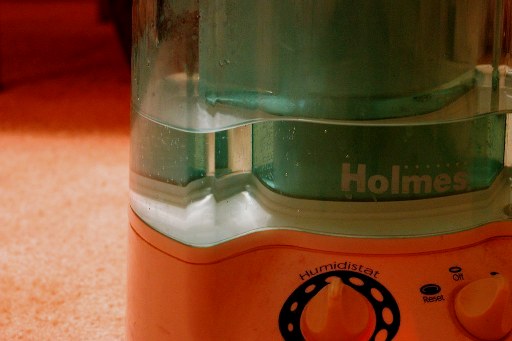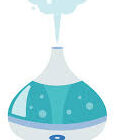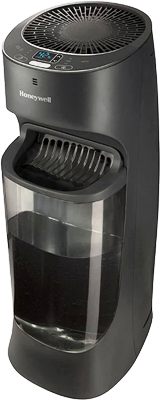Can a Humidifier Spread Mold? The Terrible Side of Humidifiers
If you live in places that experience dry air throughout the year or during the winter, you need a humidifier. It raises the humidity level in your house by releasing mist.
But there is a dark side to humidifiers that most people ignore. Since it is in constant contact with water and mold forms in damp places, can a humidifier cause mold in a room?
This is a fair question, indeed. If you read my posts on 10 warning signs of mold toxicity, you will see why you need to be TERRIBLY afraid of this nasty fungus (toxic black mold).
This means knowing how to prevent the formation of toxic black mold or black mold, which means checking any high-humidity place at home constantly. A humidifier is a high-humidity appliance.
So, will a humidifier cause mold? If you do not clean your humidifier on time and with white vinegar, hydrogen peroxide, or bleach, it can grow mold. The symptoms of mold in humidifiers include black, gray, green, or pink slime on their walls or in the water. It can spread mold spores through the mist, which could possibly start a mold colony at home.
Do humidifiers cause mold in rooms?
The dark truth about humidifiers is that they are in a constant state of moisture. This creates a good environment for mold to grow.
Mold needs three things to grow. These are moisture, nutrients, and a surface to grow on. A mister provides the moisture that mold needs to grow.
The mold’s nutrients come from phosphate buildup, which can come from the minerals in the water or from other sources.
You can see how the tap water used in a humidifier can provide nutrients for mold growth when you don’t clean it properly.
Placing the humidifier on a dirty carpet or wooden surface can provide a surface for mold to grow on. No matter how careful you are, the humidifier makes the area around it damp.
All humidifiers, even the small humidifiers for 2×2 grow tents can cause mold growth. Warm mist units, cool mist ones, and evaporative and ultrasonic humidifiers can all cause mold growth if you let them raise the humidity too high.
The main culprit for causing mold is too high humidity levels indoors. If there are nutrients and a surface to grow on, yet the humidity level stays below 55%, mold will not grow.
All humidifiers can cause excess humidity in your house if they are not used properly.
How a humidifier causes mold in a room

We have already mentioned how it is possible to have black mold in a humidifier. Even without the humidifier itself having mold inside that it dispenses with the mist, it can still cause mold growth in other ways. How?
1. When it raises humidity excessively
Most small portable humidifiers do not have a built-in humidistat. For instance, when you check the Pure Enrichment humidifier instructions, you will see that it has three mist settings. These are low, medium, and high.
As long as the unit has water in the tank, it will continue running. The Pure Enrichment humidifier stops working only when it runs out of water.
Thus, even if the desired humidity level has been reached, the humidifier continues to release more mist.
In our post on mold grows at what humidity, we said 60 percent and above. If the portable humidifier continues to release mist, it eventually exceeds this level.
Mold can grow in a couple of days, as you can see in the mold growth humidity chart.
But there is a solution, that is, apart from checking the humidity level on a hygrometer so that you can know when to switch off the unit.
You could order the Honeywell Tower Humidifier with Built-in humidistat on Amazon.com.
Once the set humidity level has been reached, it switches off automatically. It costs more than the regular portable units, but it is worth it.
2. When the humidifier is too large for a room
Portable humidifiers have a space rating. You must know the size of your space before you order one.
For instance, a small humidifier for a 4×4 grow tent would be perfect for 250 to 500 square feet. Use it in such a space only. If you use it in a smaller space, it will raise the humidity too fast, which would cause mold to thrive.
If you have a large portable unit such as the Honeywell HCM350 Germ-free humidifier, set it in the room with the driest air, and then place it close to the door. Open the doors of the other rooms so that it can dehumidify the whole house.
For a furnace humidifier, set the humidistat at 30 to 50%. It will stop adding moisture to the air as soon as the set humidity level is achieved.
For the rest of the humidifiers without a humidistat, keep an eye on the hygrometer. That way, you can switch the unit off as soon as it has raised the humidity to appropriate levels.
3. The humidifier is too dirty
If you see pink mold in the humidifier, it is because you have kept the unit too dirty for too long. Depending on how frequently you use it, clean it as needed.
The problem with keeping a humidifier dirty is that whatever is in the tank is released with the mist.
Do you see black dots on the tank? That is a sign of black mold in the unit. It will be released with the mold. It will then cause symptoms of mold exposure in babies.
If you are using the unit daily, clean it daily. When you are using it a few times a week, clean it two to three times a week.
Remember to clean the area around where you place the humidifier. Also, don’t place it on the floor. Place the humidifier three feet from the floor.
If the unit has been in storage, clean it before you start using it again. When you have a whole house humidifier, have a technician do proper maintenance as recommended by the manufacturer.
4. Poor humidifier placement
Choosing the best humidifier position is everything!
A humidifier should be placed in an elevated position, at least two feet from the walls. Also, the nozzle should be facing away from the wall.
If you leave it facing the wall, it will cause excess moisture, and mold will start growing on the wall. It will pump mist at the wall until water starts rolling down the wall to the floor.
Do not place the unit with the nozzle facing the furniture. Mold will also grow on wooden furniture.
If the mist from the unit gets to the floor, it will make the carpets damp. Mold will then start growing under the carpet. If you are getting a musty smell in the house, it is because mold is growing somewhere.
5. When you use the unit for too long
Don’t use a humidifier for longer than necessary. Once it has raised the humidity to your desired level, stop it. If it continues running, it will only raise the air moisture to levels that cause mold growth.
Do not use the humidifier every day unless it is really necessary. The humidity gets to the crawl spaces, where it can cause mold to thrive undetected.
If you have a hygrometer, place it in different rooms to read the humidity level. If you notice that it is higher than 50% in the basement, bathroom, or kitchen, run a dehumidifier.
Does a humidifier increase mold?

A humidifier is more likely to increase mold colonies in your house than cause it outright. If it raises the humidity level to 60% or above, the mold will increase.
The Environmental Protection Agency says that mold can grow anywhere if there is moisture and a food source. It will grow on paper, carpet, or wood.
Mold spores float in the air, and they can land in any space. If the conditions are right, they will start new colonies of this fungus.
If not, the spores don’t just die. They stay dormant, and once the conditions are right, they will start mold growth.
If there is dry air, the spores will stay in place. When the humidifier raises the humidity, they will start new colonies.
You can prevent the humidifier from increasing mold by ensuring it never raises the humidity level above 50%.
Today, more than 45% of the homes in the USA have mold infestations. This is attributable to the high humidity in Florida, and elsewhere.
If you have been running a humidifier, and you start to see the signs of mold exposure in toddlers such as sore throat, wheezing, breathlessness, watery eyes, and runny nose, there is mold.
Also check out my article on: Can mold grow in the freezer?
Wrapping up
A humidifier will increase mold in your home, and it can start mold growth where there was none before.
If you have a baby, you should be on the lookout for black mold growth. This dangerous allergen can cause serious mold toxicity symptoms in babies.
If left unchecked, the humidifier will make the room wet. It will also dampen your carpet. A damp room creates a perfect environment for mold growth.
Throughout the year, make sure the indoor humidity level stays at 30 to 50%. Mold cannot grow at that air moisture level.
If you have a fungus infestation, contact fumigation services to get rid of it.
Also remember to check my posts on:
Air purifier or dehumidifier for musty smell
Can mold cause sinus infection
Is Air Purifier Good For Mold?


